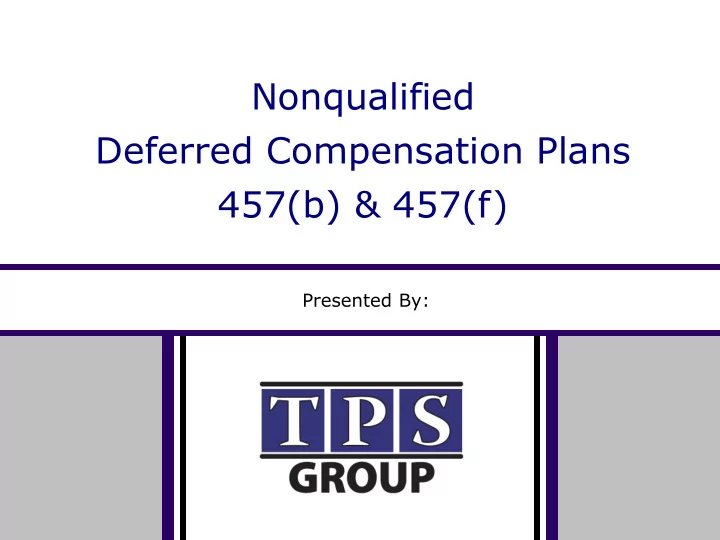

Nonqualified Deferred Compensation Plans 457(b) & 457(f) Presented By:
Nonqualified Deferred Compensation What is it? Nonqualified Employer Retirement Savings Plan that does not meet the tax and labor law (ERISA) requirements for qualified pension plans. Used to provide retirement benefits to a select group of executives or key personnel or to provide supplemental benefits beyond those provided by company’s qualified plan Must be corporation, tax exempt organization or governmental agency 457(b) plans can include employee deferrals, employer match and employer non-elective contributions. Combined these contributions are subject to the annual deferral limit of $1 9,0 00 for 201 9 .
Nonqualified Deferred Compensation What is it? 457(f) plans: often termed an “ineligible” non - qualified deferred compensation plan because employers are permitted to provide compensation in amounts that exceed limitations imposed on 457(b) “eligible” plans. Most plans are designed as non-elective plans with employer provided contributions only. Contributions in these plans can exceed the annual deferral limit of $1 9,0 00 for 201 9 . Can also be referred to as Top-hat, SERP or Excess Benefit Plan.
Advantages? Involves minimal IRS, ERISA and other regulatory requirements such as reporting & disclosure, fiduciary funding requirements, etc. More plan design flexibility than qualified plans. Allows coverage for a group of employees or even a single employee without any non-discrimination requirements. Allows Employer to provide different benefit amounts for different employees on different terms & conditions. Restores contributions/benefits limited by IRS restrictions in qualified retirement plans. Employee can defer max amount($1 9,0 00 for 201 9 ) to 457(b) and max to 401(k)/403(b) This is an attractive feature for those key employees really looking to maximize their retirement savings.
Advantages ? Can be used as a form of “golden handcuffs” that help bind the employee to the company. Plan can provide forfeiture of benefits according to a vesting schedule for almost any contingency such as, terminating employment before retirement or misconduct or going to work for competitor Nonqualified plans can help solve 4R problem: (recruit, retain, reward, retire) Deferral of taxes to participants until constructively received (note: Social Security and FICA taxes still apply in certain situations. You should consult tax expert for guidance. )
Disadvantages ? Tax exempt 457 must restrict eligibility to a select group of executives or key personnel. From executive point of view, the lack of security based on company’s unsecured promise to pay. Employer insolvency. No ERISA protection. For 457(b) plans the annual deferral limit ($1 9,00 0 for 201 9 ) includes employee deferrals, employer match and employer non-elective contributions. This could become an issue if the employer is making a significant employer contribution to the plan.
Investment of Assets Until distribution, all assets shall remain solely the property and rights of the employer, subject only to the claims of the employer’s general creditors. Considered “Unfunded” for tax and ERISA purposes. Employer can elect to informally fund into a “ Rabbi Trust” (assures employee that the employer will have liquidity to pay promised benefits) “Rabbi Trust” will not protect against employer’s insolvency . Participants can elect how to invest the assets of the plan.(i.e. mutual funds, etc.)
Timing of Taxation Participant is taxed on accumulations when a substantial risk of forfeiture lapses, regardless of when the funds are received by the participant Constructive receipt Participant may elect timing and form of distribution if election is made prior to date distribution is made available Distributions are taxed as wages and withholding is reported via W2. Participant can make 1 subsequent election, prior to commencement of distributions, to further delay distribution
Distribution Rules 457(f) Plans Participant elects the distribution dates for the payment of benefits. Usually coordinated with the substantial risk of forfeiture event Tax-exempt 457 plans cannot roll or accept rollovers Tax-exempt 457 plans cannot make participant loans Reported on W-2 457(b) Plans Withdrawals permitted after severance of employment • Must start receiving benefits by April 1 following later of • retirement or age 70 ½ Plan loans not permitted •
The Next Step What is the Employer’s objective with the Retirement plan? Whom do you want to benefit in the plan? What level of benefit do you wish to provide? What do you want to establish as the “substantial risk of forfeiture event? (ie.. When is the employee entitled to the benefit?)
Questions… Philip S. Coco TPS Group 127 Washington Ave, West Wing North Haven, CT 06473 (203) 691-4040 pcoco@tpsgroup.com www.tpsgroup.com
Recommend
More recommend